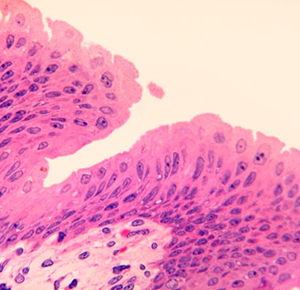|
 Stratified
cuboidal epithelium. Stratified
cuboidal epithelium.
- This epithelial type is not
common and is found primarily in the largest ducts of salivary
glands.
- The epithelium consists of 2 or
3 layers of cuboidal or low columnar cells.
Transitional epithelium
- This type is found only in
the urinary tract and is highly specialized to resist the toxic
effects of urine and to "stretch".
- The most
distinguishing features are that most of the superficial cells
are
- Rounded, not squamous, and
- The basement membrane is very
thin and is not visible by LM.
- Generally 6 to 8 layers thick.
- The transitional epithelium of the bladder appears to get
thinner and the cells flatten as the organ becomes distended
with urine.
Why is this epithelium not
referred to as stratified? In what sense is it transitional?
On to secretory
epithelia and glands. |